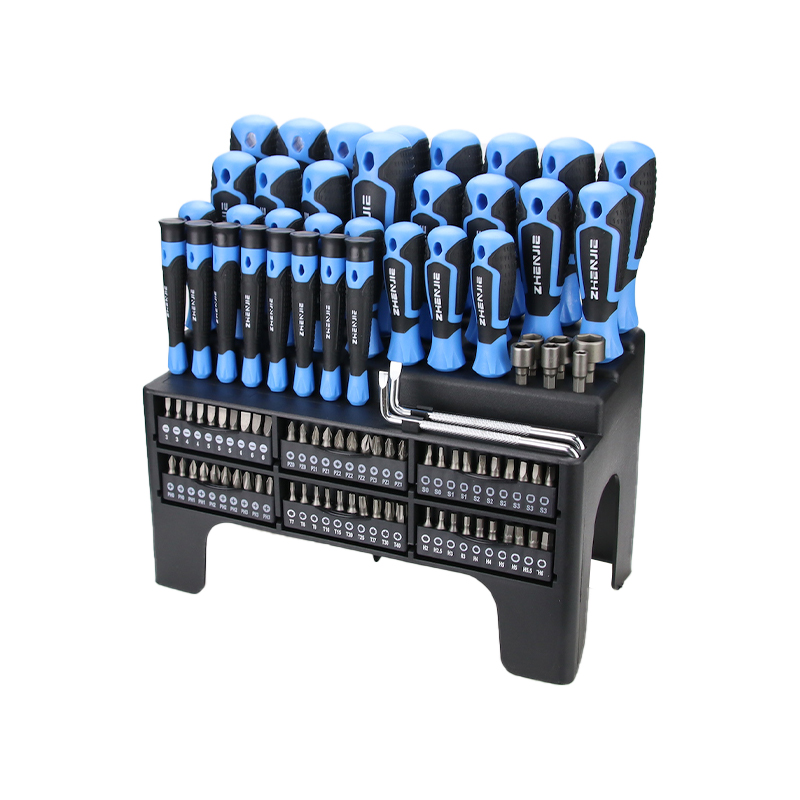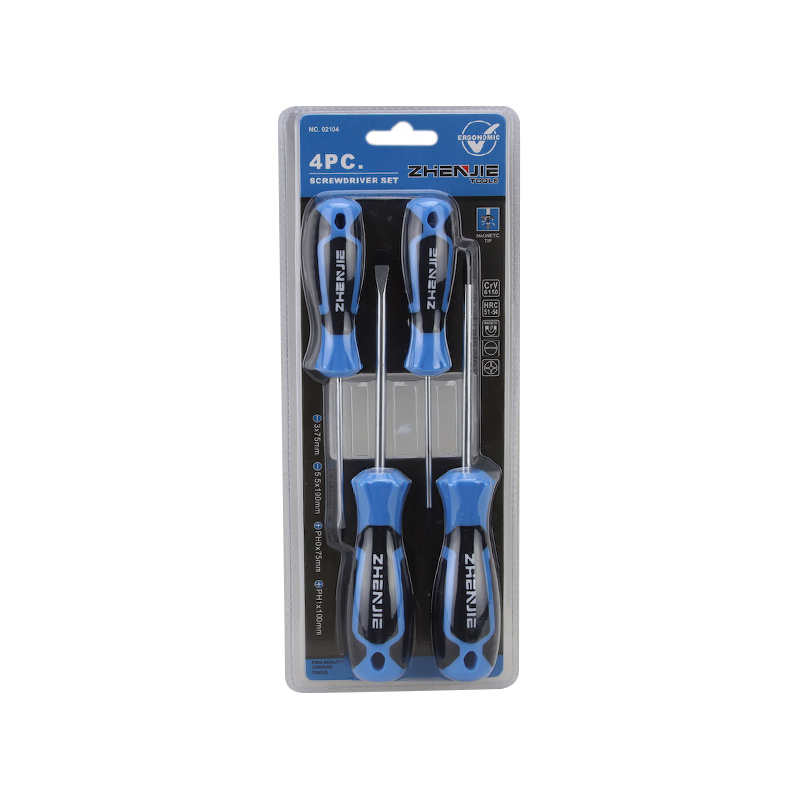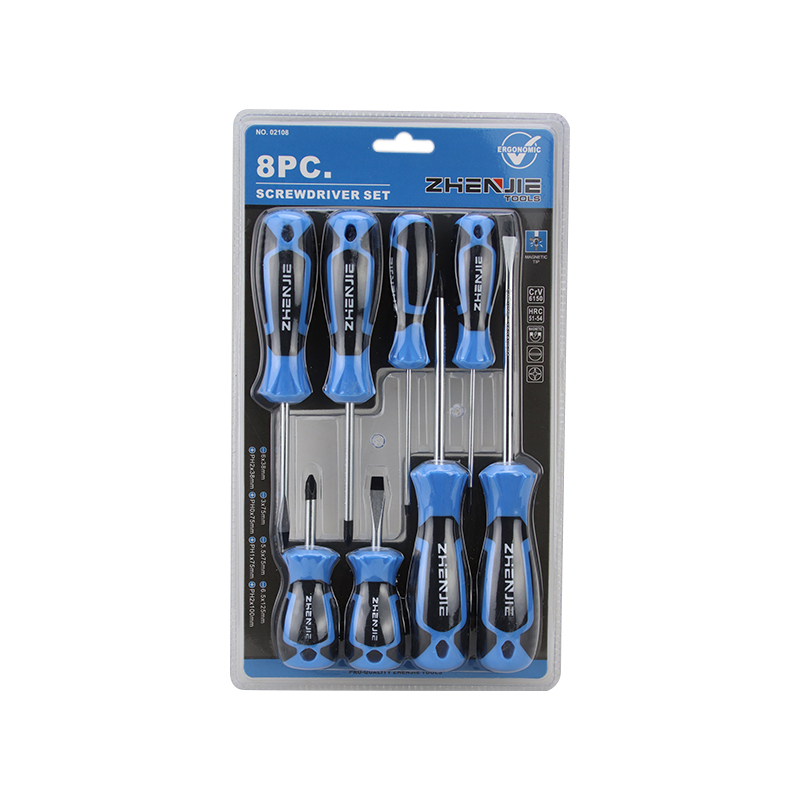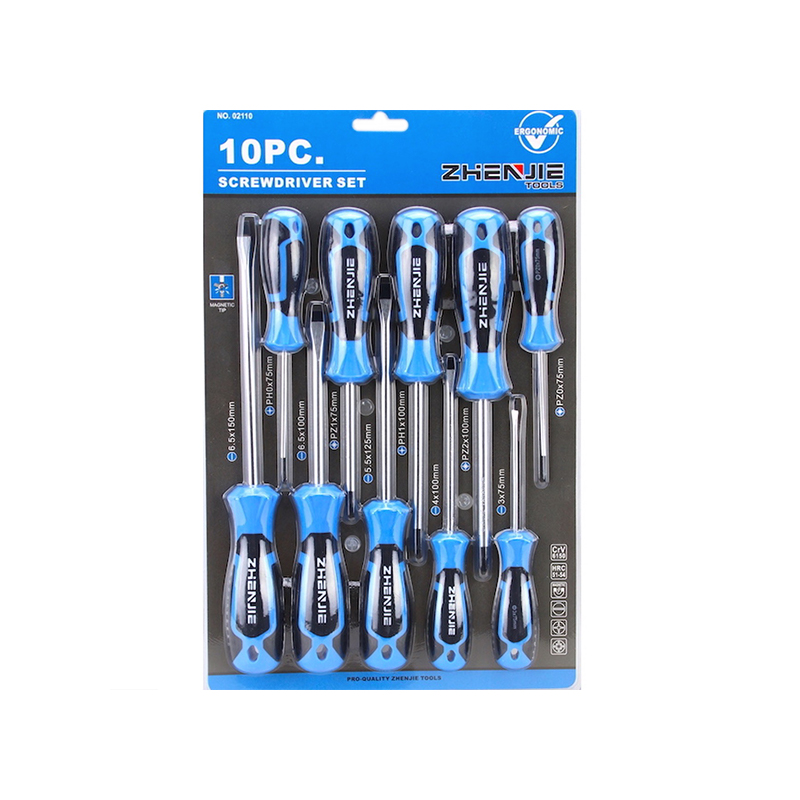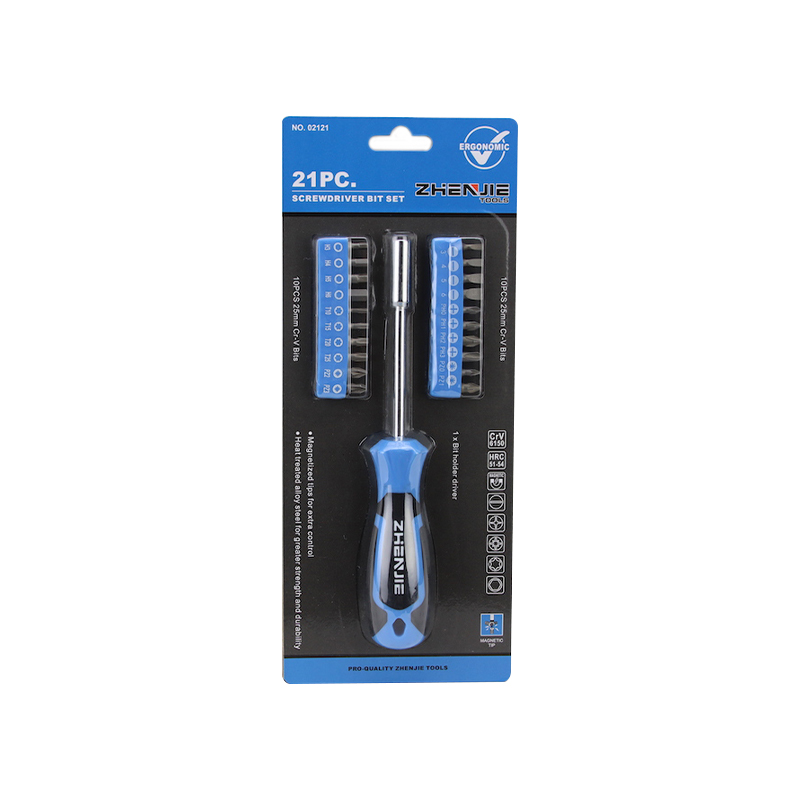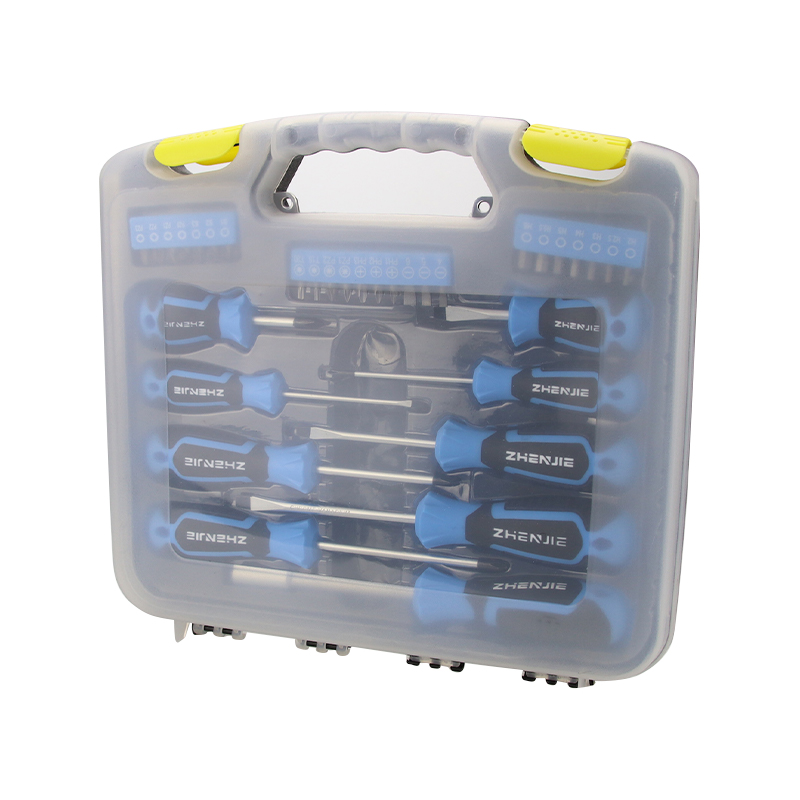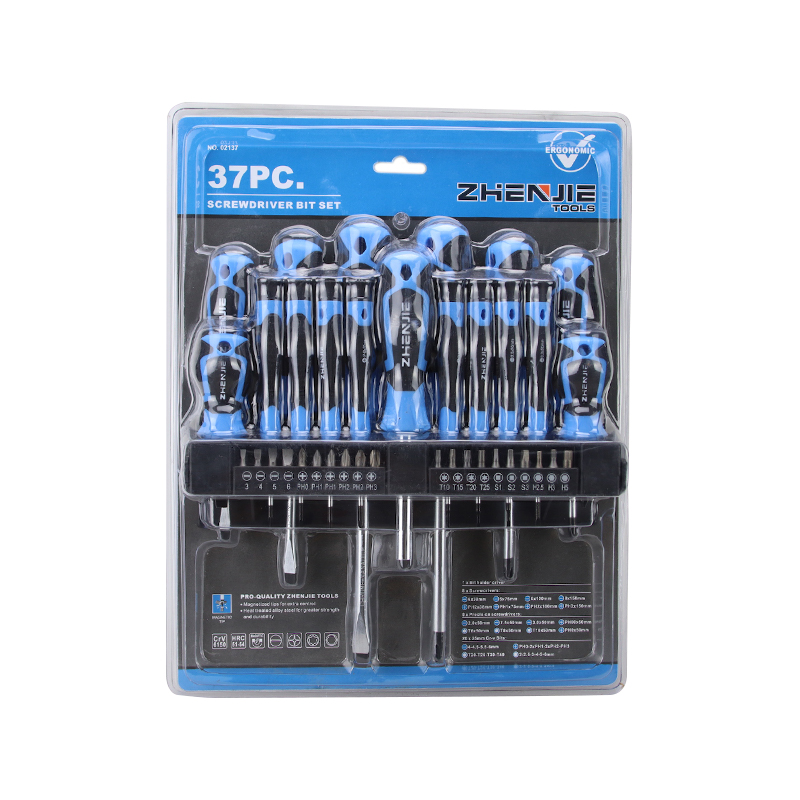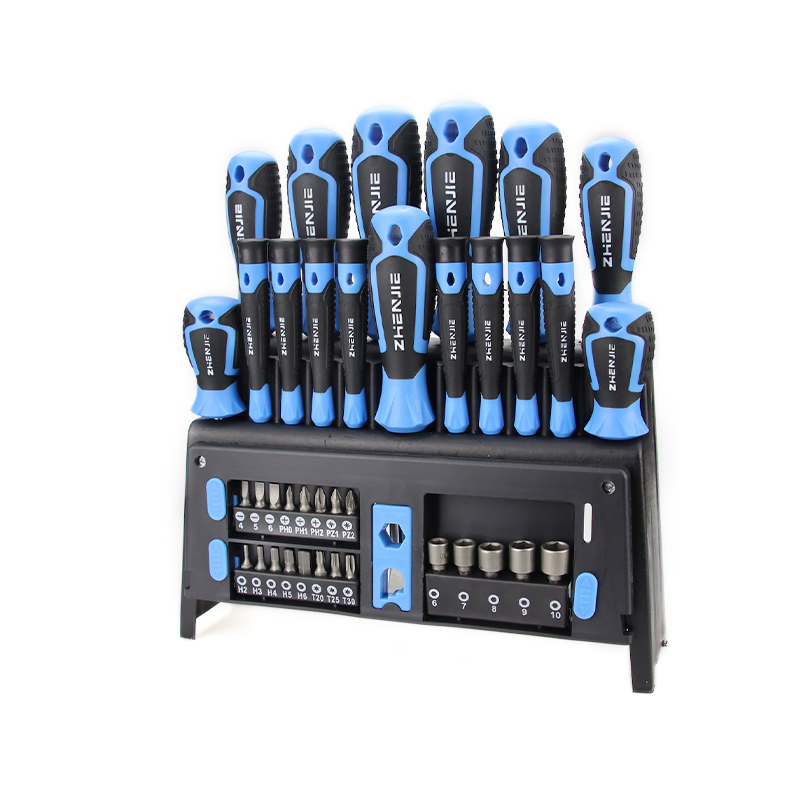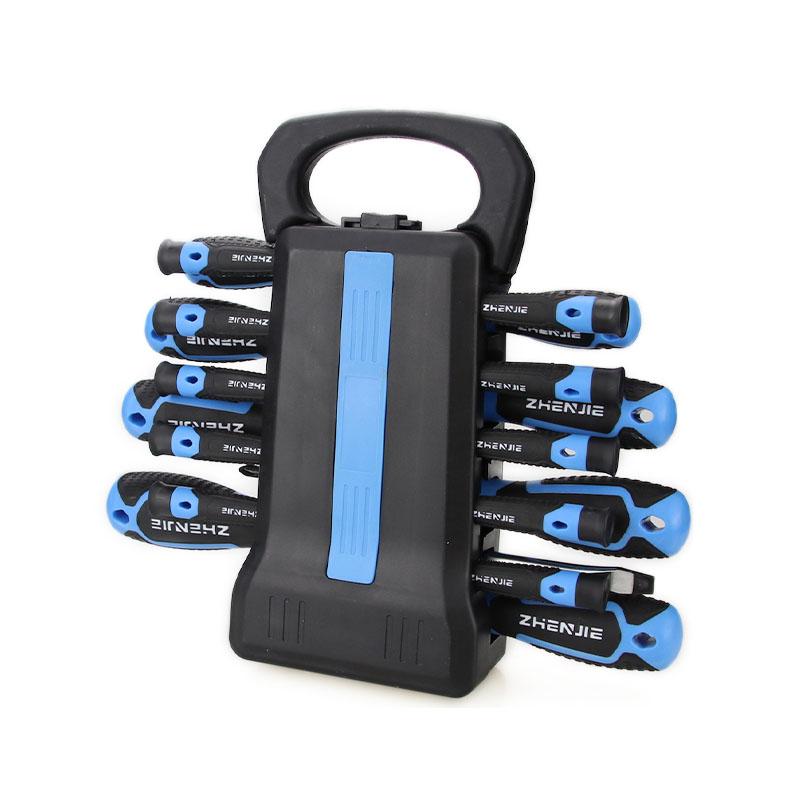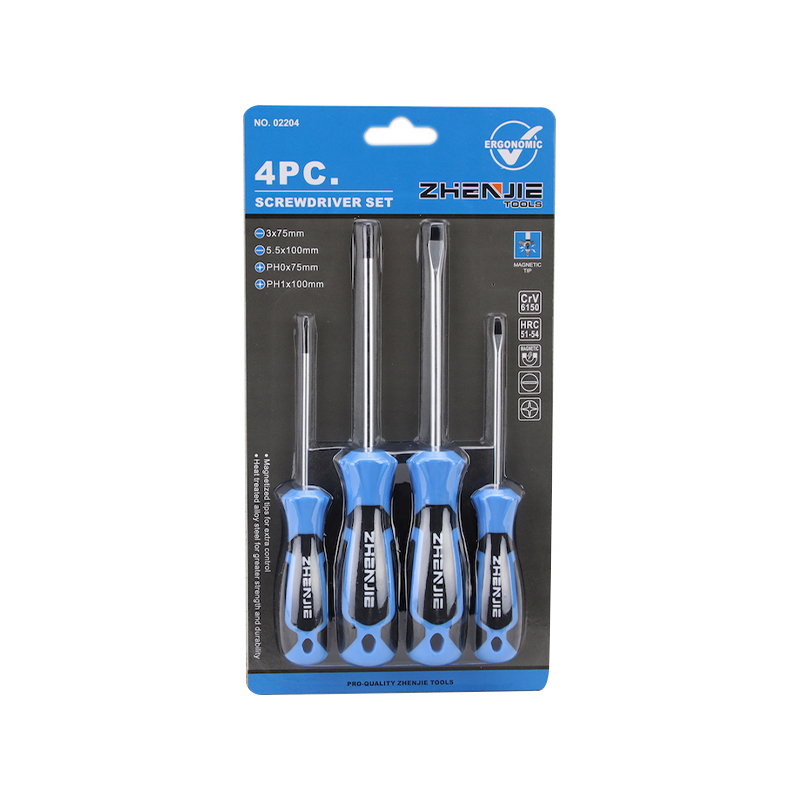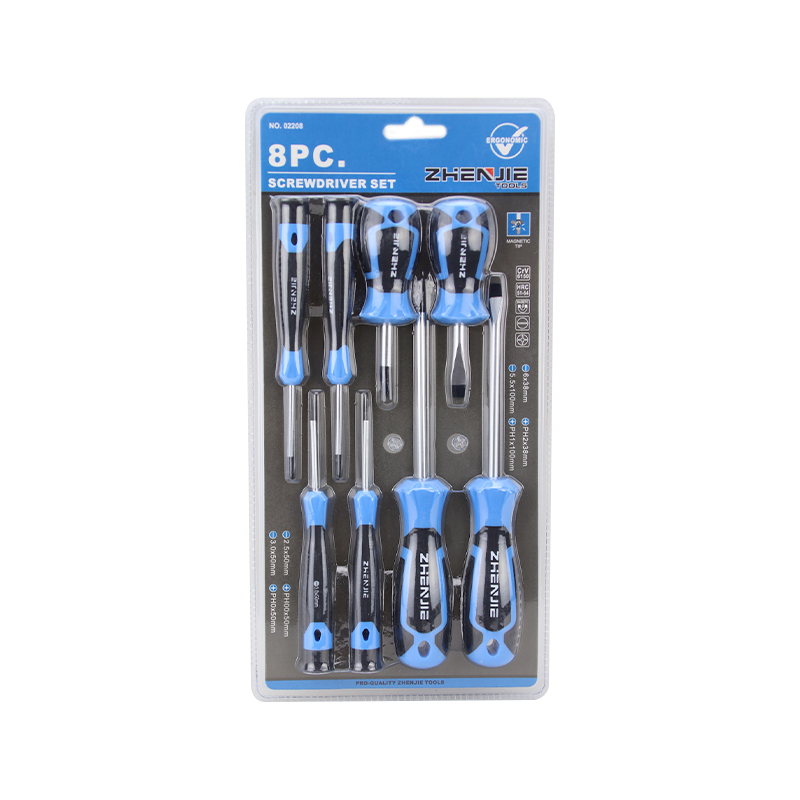At a time when technology and life are deeply integrated, from small electronic devices such as smartphones and tablets to slightly larger electronic products such as laptops and game consoles, to exquisite watches, jewelry and various small mechanical devices, while they bring us convenience and pleasure, they are also inevitably in need of repair or maintenance. At this time, a set of high-quality precision screwdriver sets has become an indispensable assistant. With its rich and diverse specifications, fine workmanship and excellent performance, precision screwdriver sets provide us with the possibility to cope with various precision operations. Whether it is professional technicians, such as electronic equipment repairers, watchmakers, jewelers, or enthusiasts who are keen on DIY, they can find tools to solve problems in precision screwdriver sets.
1. Composition of precision screwdriver sets
(I) Diverse types of screwdriver heads
Phillips screwdriver heads
The Phillips screwdriver head is one of the most common types. Its shape is cross-shaped and perfectly matches the corresponding cross screws. In the field of electronic equipment, many laptop shell fixing screws and some screws inside mobile phones are cross-shaped. Taking Apple laptops as an example, most of the screws at the bottom of the body are cross screws. Using a matching cross screwdriver head can accurately engage with the screw head during disassembly and installation, apply stable torque, ensure smooth screwing of the screw, and avoid damage to the screw slot or surrounding parts due to slipping. In common precision screwdriver sets, there are often cross screwdriver heads of different sizes, such as PH000, PH00, PH0, PH1 and other specifications to meet the operation requirements of screws of different sizes.
Slotted screwdriver head
The shape of the slotted screwdriver head is flat and suitable for slotted screws. Slotted screws are often seen in the assembly of some older electronic devices, small appliances and furniture. For example, some traditional mechanical alarm clocks have mostly slotted screws as the internal fixing screws. When using a slotted screwdriver head, the screwdriver head needs to be accurately embedded in the screw slot, kept vertical and applied with appropriate force to twist. The sizes of the slotted screwdriver bits in the set also vary, from very fine models for tiny screws to slightly larger models for larger screws. Common widths include 0.8mm, 1.0mm, 1.5mm, and 2.0mm.
Torx screwdriver bits
The Torx screwdriver bits are in the shape of a plum blossom. Due to their unique design, they can provide greater torque when twisting and are not easy to slip. They are suitable for some occasions with high requirements for fastening. In computer hardware, such as hard disk fixing screws and graphics card mounting screws, Torx screws are often used. Some Dell server hard drives use Torx screws. In precision screwdriver sets, Torx screwdriver bits usually include T1, T2, T3, T4, T5, T6 and other specifications to adapt to Torx screws of different sizes and uses.
Hex screwdriver bits
The hex screwdriver bits are hexagonal and are mainly used to twist hex nuts or screws with hexagonal holes. Hexagonal screws are common in some small mechanical equipment, models, and the internal structures of some electronic devices. For example, the motor fixing screws of some drones are designed with hexagonal design. In precision screwdriver sets, hexagonal screwdriver heads generally have multiple sizes, such as 1.5mm, 2.0mm, 2.5mm, 3.0mm, etc., to meet the maintenance needs of different equipment.
Other special types of screwdriver heads
In addition to the common types of screwdriver heads mentioned above, precision screwdriver sets may also include some special types of screwdriver heads. For example, Y-type screwdriver heads are often used for some special electronic equipment screws, such as battery fixing screws of some brands of mobile phones; U-type screwdriver heads may be used in the maintenance of some specific mechanical devices; and Pentalobe screwdriver heads are used to remove the five-pointed screws unique to Apple products. Although these special types of screwdriver heads have relatively narrow usage scenarios, they play a key role in the maintenance of specific equipment, reflecting the professionalism and comprehensiveness of precision screwdriver sets.

(II) Humanized handle design
Material and feel
The material of the handle is crucial to the user experience. The handles of high-quality precision screwdriver sets are usually ergonomically designed, and the materials are mostly non-slip and comfortable. The most common material is rubber, which has good non-slip properties. Even when the hands are sweating, it can ensure that the user holds the screwdriver firmly to avoid slipping during operation, which may cause the screws to slip or damage the equipment.
Rotation and operation convenience
In order to improve the convenience of operation, many precision screwdriver handles are designed with a rotation function. The tail of the handle is usually equipped with a rotatable part. When a long-term screwing operation is required, the user does not need to frequently turn the wrist. Just gently turn the rotating cap at the tail of the handle to easily rotate the screwdriver. This design greatly reduces hand fatigue, especially when dealing with a large number of screws. The advantages are more obvious. Some handles are also designed with an adjustable torque function. Users can adjust the torque output of the handle according to the tightening requirements of different screws to avoid damage to screws or equipment due to excessive torque, further improving the accuracy and safety of the operation.
(III) Rich accessories

Extension rod
The extension rod is one of the very practical accessories in the precision screwdriver set. When repairing some devices with complex internal structures and deep screws, ordinary length screwdrivers often cannot reach them. At this time, the extension rod can play an important role. It can be connected between the screwdriver handle and the screwdriver head to increase the overall length of the screwdriver, allowing users to easily reach deep screws. For example, when repairing screws deep inside the desktop computer host, the extension rod can be used for convenient operation. The length of the extension rod generally has a variety of specifications, the common ones are 50mm, 100mm, 150mm, etc., to meet the needs of different depths. Some extension rods also adopt a retractable design, and users can freely adjust the length according to actual conditions, which is more flexible and convenient.
Tweezers
Tweezers are indispensable in precision operations, especially when handling tiny parts, screws or electronic components. It can help users accurately grasp and place parts to avoid contamination or damage to parts caused by direct contact with fingers. When disassembling and installing tiny screws, chips and other components inside mobile phones, tweezers can accurately remove or put screws in small spaces. Tweezers in precision screwdriver sets are usually made of stainless steel, which has high hardness and wear resistance, and the tip is fine and sharp, which can easily pick up very small objects. The length of tweezers is generally between 100mm and 150mm, which is convenient for users to operate, and some tweezers are also magnetic, which can absorb tiny metal parts to prevent parts from being lost.
Crowbar
Crowbars are mainly used to open the housing of the device or separate tightly connected parts during repair. When disassembling the housing of some electronic devices that are not fixed with screws but connected by buckles, the crowbar can be carefully inserted into the gap and gently pried to separate the buckle, thereby avoiding the use of brute force to damage the device housing. For example, when disassembling the housing of a tablet computer, the crowbar can be used to pry along the gap of the housing step by step to safely open the housing. Crowbars are generally made of metal materials with higher hardness, such as aluminum alloy or stainless steel, to ensure that they will not bend or break during prying. The head is usually designed to be flat and sharp, which is convenient for inserting into narrow gaps. At the same time, some pry bars also use special anti-slip treatment on the head to increase the friction with the surface of the object, making the prying operation more stable.
Storage box
A good storage box is essential for precision screwdriver sets. It not only protects the tools, but also makes it convenient for users to organize and carry the tools. Storage boxes are generally made of sturdy and durable materials, such as plastic or metal. Plastic storage boxes have the advantages of light weight, low cost, and corrosion resistance. Common storage boxes are made of ABS plastic. Metal storage boxes are more sturdy and can better protect the internal tools, such as aluminum alloy storage boxes. The storage box is usually designed with special grooves or compartments for placing screwdriver heads, handles, extension rods and other accessories of different types and sizes, so that each tool can have a fixed position to avoid collisions and damage during carrying. Some advanced storage boxes also come with portable handles or backpack straps, which are convenient for users to carry with them. Whether at the work site or out for repair, you can easily carry the whole set of tools.
2. Materials and craftsmanship of precision screwdriver sets

(I) Material of screwdriver heads
Chrome vanadium steel (CR-V)
Chrome vanadium steel is a high-quality alloy steel widely used in the manufacture of screwdriver heads. It contains alloy elements such as chromium (Cr) and vanadium (V), and the addition of these elements significantly improves the strength, hardness and wear resistance of the steel. Chromium can form a dense oxide film on the surface of steel to enhance the corrosion resistance of steel; vanadium can refine the grains of steel and improve the toughness and fatigue resistance of steel. Screwdriver heads made of chrome vanadium steel have a high hardness, generally up to HRC50-HRC55, can withstand large torque, and are not easily deformed or damaged when screwing.
S2 tool steel
S2 tool steel is also a material commonly used in the manufacture of high-end precision screwdriver heads. It is an alloy tool steel containing a variety of alloy elements such as carbon (C), silicon (Si), manganese (Mn), chromium (Cr), molybdenum (Mo), and vanadium (V). S2 tool steel has excellent comprehensive performance. Its hardness can usually reach HRC58 - HRC62, which is higher than chrome vanadium steel. Therefore, it can provide stronger torque transmission capacity and is suitable for turning some screws with higher hardness and greater tightening force. At the same time, S2 tool steel also has good toughness and wear resistance. During frequent use, the screwdriver head is not prone to chipping and breaking.
Carbon steel
Carbon steel is a steel with iron and carbon as the main components. According to the carbon content, it can be divided into low carbon steel, medium carbon steel and high carbon steel. In the manufacture of precision screwdriver heads, medium carbon steel or high carbon steel is generally used. Carbon steel has a certain hardness and toughness, and the cost is relatively low, so it is more common in some mid-to-low-end precision screwdriver sets. However, compared with chrome vanadium steel and S2 tool steel, carbon steel has poor corrosion resistance and is easy to rust. In order to improve its anti-rust performance, carbon steel screwdriver heads are usually surface treated, such as zinc plating, nickel plating, etc.
(II) Material of handle
Rubber
Rubber is a commonly used handle material, which is popular for its good anti-slip and soft touch. Rubber handles can provide users with a comfortable grip, and can effectively prevent the screwdriver from slipping out of the hand even when the hands are sweating, ensuring the safety and stability of the operation. Rubber material also has certain shock absorption properties, which can reduce the vibration of the hand when screwing the screw and reduce fatigue.
Plastic
The handle made of plastic has the advantages of light weight, low cost, and easy molding. Common plastics used to make handles include polypropylene (PP) and polycarbonate (PC). PP plastic has good chemical corrosion resistance and low density. After molding, the handle is light and easy to carry. PC plastic has high strength and transparency, and the handle made is more durable and beautiful. Some plastic handles also add reinforcing materials such as glass fiber to improve their strength and rigidity.
Metal
Metal handles are used in some high-end precision screwdriver sets, and common ones are aluminum alloy and stainless steel. Aluminum alloy handles have the advantages of light weight, high strength, and corrosion resistance. After anodizing and other surface treatments, aluminum alloys can not only improve their hardness and wear resistance, but also make their surface present a beautiful color. Stainless steel handles have higher strength and better corrosion resistance, but they are relatively heavy. Metal handles can add a sense of texture and durability to screwdrivers. At the same time, in some occasions where the appearance and quality of tools are required to be high, metal handles can better demonstrate their professionalism.
(III) Manufacturing process
Forging process
Forging is a processing method that applies pressure to metal blanks to cause them to undergo plastic deformation, thereby obtaining forgings with certain shapes, sizes and properties. In the manufacture of precision screwdriver heads, the forging process can make the internal structure of metal materials denser and the grains more refined, thereby improving the strength, hardness and toughness of the screwdriver heads. During the forging process, the metal blank is repeatedly hammered or squeezed in the mold, so that its internal defects are eliminated and the performance of the material is significantly improved. For example, some high-end precision screwdriver heads are manufactured using a hot forging process, where the heated metal blank is placed in a mold and a large pressure is applied by a press to form the blank in the mold. The mechanical properties of the forged screwdriver head
The performance is significantly better than that of screwdriver heads made by other processing methods. It can withstand greater torque and impact force and is more reliable and durable during use.
Heat treatment process
Heat treatment is a process method for heating, keeping warm and cooling metal materials to change their organizational structure and performance. For precision screwdriver heads, the heat treatment process is crucial. Through proper heat treatment, the hardness, toughness and wear resistance of the screwdriver head can be adjusted to achieve the best performance. Common heat treatment processes include quenching and tempering. Quenching is to heat the screwdriver head to above the critical temperature, keep it warm for a certain period of time and then cool it rapidly to obtain a high-hardness martensitic structure. Tempering is to heat the screwdriver head to a temperature range below the critical temperature after quenching, keep it warm for a certain period of time and then cool it to eliminate quenching internal stress, reduce hardness and improve toughness.
Surface treatment process
Surface treatment process can improve the corrosion resistance, wear resistance and aesthetics of precision screwdrivers. Common surface treatment processes include chrome plating, nickel plating, blackening, etc. Chrome plating is to plate a layer of metal chromium on the surface of the screwdriver. The chromium layer has good corrosion resistance and decorative properties, which can make the surface of the screwdriver as bright as a mirror and improve its wear resistance. Nickel plating is to plate a layer of nickel on the surface of the screwdriver. The nickel layer has good corrosion resistance and weldability, which can protect the screwdriver from erosion by the external environment. Blackening treatment is to form a black oxide film on the surface of the screwdriver by chemical methods. This oxide film can not only improve the corrosion resistance of the screwdriver, but also increase the friction of its surface, making the screwdriver more stable during use.
III. Applicable scenarios of precision screwdriver sets
(I) Electronic equipment repair
Mobile phone repair
In the field of mobile phone repair, precision screwdriver sets play a vital role. Today's smartphones have increasingly complex internal structures and higher integration, and the repair process requires a high degree of precision and meticulousness. Starting from disassembling the mobile phone shell, different types of screwdriver heads are needed. For example, the shell screws of Apple mobile phones usually use Torx or Pentalobe screws, which require corresponding Torx screwdriver heads or Pentalobe screwdriver heads for disassembly. After opening the shell, the fixing screws of the motherboard, battery, camera and other parts inside the mobile phone are of various types, such as cross and flat. When removing and installing these tiny screws, you must use a precision screwdriver to ensure that the screws are not damaged and avoid damage to other precision parts inside the mobile phone. When replacing the battery of a mobile phone, you need to first use a precision screwdriver to unscrew the screws that fix the battery, and then carefully use a pry bar to separate the connection cable between the battery and the motherboard. During the whole process, the precise operation of the precision screwdriver is the key to ensure the success of the repair.
Computer repair
Whether it is a laptop or a desktop computer, the precision screwdriver set is indispensable during the repair process. The shell of a laptop is usually fixed with screws of various specifications, such as cross screws, plum screws, etc. During the removal and installation process, it is necessary to select the appropriate screwdriver head according to the type and size of the screws. When replacing the hard disk, memory, cooling fan and other parts of the laptop, you also need to use a precision screwdriver to turn the corresponding screws. For desktop computers, although the screws of its internal components are relatively large, in some details, such as the CMOS battery fixing screws on the motherboard and the fixing screws of the chassis fan, precision screwdrivers are still required for operation. Precision screwdriver sets are also essential tools for maintenance work such as cleaning dust inside the computer and checking hardware connections.
Tablet computer repair
The repair of tablet computers also requires the help of precision screwdriver sets. The outer shell of a tablet computer is generally fixed by a combination of buckles and screws. When removing the outer shell, you need to carefully open the buckle with a pry bar first, and then use a precision screwdriver to unscrew the screw. The fixing screws of the motherboard, screen, battery and other components inside the tablet are also relatively small, and require the use of precision screwdrivers of corresponding specifications. For example, when replacing the screen of a tablet computer, you need to use a precision screwdriver to unscrew the screws that fix the screen frame to safely separate the screen from the body. If the operation is improper, it is easy to damage the screen cable or other components inside the body. At this time, the precise operation of the precision screwdriver set is particularly critical.
(II) Watch repair
Mechanical watch repair
The internal structure of a mechanical watch is sophisticated and complex, consisting of many small parts. The installation and removal of each part requires extremely delicate operation. The precision screwdriver set is an indispensable tool for watchmakers. The case of a mechanical watch is usually fixed by screws. These screws are not only small, but also have special shapes. Common ones include flathead, crosshead, and some special specifications of screws. After opening the case, the screws of the internal movement parts, such as the fixed gears, escapement, barrel and other parts, are even smaller and more fragile. Taking the removal of the screws of the mechanical watch movement as an example, it is necessary to use ultra-fine screwdriver heads, such as 0.8mm or even finer flathead or crosshead screwdriver heads, with a magnifying glass, and carefully twist the screws. The slightest carelessness may cause the screws to slip or damage the movement parts. During the installation process, it is also necessary to accurately control the torque of the screwdriver to ensure that the tightening degree of the screws is just right, which can not only ensure the stability of the parts, but also prevent the screws or parts from being damaged due to excessive torque.
Quartz watch repair
The repair of quartz watches also relies on precision screwdriver sets. Although the internal structure of a quartz watch is relatively simple compared to a mechanical watch, there are also many small parts that need to be removed and installed. For example, the battery cover of a quartz watch is usually fixed by screws. These screws are extremely small, generally between 1.0mm and 1.5mm, and require a matching micro screwdriver head to be successfully removed. When replacing a quartz watch battery, in addition to opening the battery cover, you also need to unscrew the screws that fix the battery holder, remove the old battery and install the new battery. The precise operation of the precision screwdriver during the entire process can avoid damage to the battery holder or other circuit components. The installation of the pointer, dial and other parts of a quartz watch may also involve screw fixation, which also requires a precision screwdriver set to complete the delicate operation.
(III) Jewelry Processing and Repair
Jewelry Inlay
In the jewelry processing process, jewelry inlay is a highly technical job, and precision screwdriver sets play an important role in it. Some complex jewelry, such as rings, necklaces and pendants inlaid with multiple gems, may use screws to fix the inlay structure to ensure the stability of the gems. During the inlay process, a precision screwdriver is needed to tighten the screws that fix the gem holder to ensure that the gems are firmly inlaid without causing any damage to the gems. For example, in a diamond-encrusted ring, the diamond setting may be fixed by several tiny screws. Using a precision screwdriver to accurately adjust the tightness of the screws can keep the diamond stable in the setting without causing cracks or damage to the diamond due to over-tightening of the screws.
Jewelry Repair
When jewelry is damaged and needs repair, a precision screwdriver set is also a must-have tool. For example, some jewelry with moving parts, such as pendants that can be opened and closed, bracelets with mechanisms, etc., may have their internal connection structures fixed with screws. During the repair process, it is necessary to use a precision screwdriver to remove the screws, repair or replace the damaged parts, and then use the screwdriver to tighten the screws again to restore the normal function of the jewelry. For some jewelry with decorative screws on the surface, if the screws are loose or fall off, it is also necessary to use a precision screwdriver to reinforce or reinstall them to maintain the beauty and integrity of the jewelry.
IV. How to choose a suitable precision screwdriver set
(I) Choose according to the usage scenario
Professional maintenance personnel
For professional electronic equipment repairers, watchmakers, jewelers and other professional maintenance personnel, due to the wide variety of equipment and parts involved in their work, they have high requirements for the professionalism and comprehensiveness of the tools. They should choose a high-end precision screwdriver set with complete functions and rich tool types. Such sets usually contain a variety of common and special types of screwdriver heads, such as cross, flat, plum, hexagon, Y-type, Pentalobe, etc., and each type has a variety of different specifications to meet the needs of various complex maintenance scenarios. At the same time, the handle design should have a good grip and operating convenience, such as a rotatable handle, adjustable torque handle, etc., to improve work efficiency and operating accuracy. In addition, the set should also be equipped with high-quality extension rods, tweezers, pry bars and other accessories to facilitate the handling of various complex maintenance tasks.
DIY enthusiasts
For DIY enthusiasts, when choosing a precision screwdriver set, they can decide based on their own interests and main operating scenarios. If you are mainly engaged in DIY assembly or simple repair of electronic equipment, such as assembling computers, replacing mobile phone batteries, etc., you can choose a set that contains common screwdriver head types (such as cross, flat, plum, etc.) and relatively complete specifications, and equipped with basic extension rods, tweezers and other accessories to meet your needs. This type of set is relatively affordable and cost-effective. For example, some precision screwdriver sets for the mass market launched by brands such as Deli and Baogong can meet the daily use needs of DIY enthusiasts without causing excessive cost burden. If you are a DIY enthusiast engaged in model making, you need to choose a set that contains screwdriver heads suitable for the specifications of model screws, and consider whether there are auxiliary tools in the set, such as a small pry bar for adjusting the position of model parts.
(II) Pay attention to tool material and craftsmanship
Screwdriver head material
When choosing a precision screwdriver set, the material of the screwdriver head is one of the key factors. As mentioned above, chrome vanadium steel and S2 tool steel are commonly used materials for making high-quality screwdriver heads. For users who often need to turn high-hardness screws, it is recommended to choose a screwdriver head made of S2 tool steel, which has higher hardness and better wear resistance, can withstand larger torque, and has a longer service life. If the frequency of use is low or the performance requirements of the tool are not particularly high, the chrome-vanadium steel screwdriver head is also a good choice. It has a relatively high cost-effectiveness and can meet the general daily use needs. However, due to its poor corrosion resistance, carbon steel screwdriver heads should be selected with caution. Unless they are well surface treated, it is not recommended as the first choice.
Handle Material and Craftsmanship
The material and craftsmanship of the handle directly affect the user experience. For users who use screwdrivers for a long time, rubber or ergonomically designed plastic handles should be selected. Such handles have good anti-slip and grip, and can effectively reduce hand fatigue. Although the metal handle has a better texture, it is relatively heavy. Long-term use may increase the burden on the hand. Therefore, it is more suitable for users who have high requirements for the appearance and quality of the tool but do not use it frequently. At the same time, attention should be paid to the manufacturing process of the handle, such as whether the surface is smooth and whether there are burrs. A high-quality handle should be finely crafted and flawless to ensure comfort and safety in use.
(III) Consider the integrity and portability of the set
Tool integrity
A good precision screwdriver set should have a complete tool configuration. In addition to the screwdriver head and handle, it should also include practical accessories such as extension rods, tweezers, pry bars, etc. When choosing, check whether the types and quantities of tools in the set meet your own needs and ensure that suitable tools are available for various operations. For example, if you often need to repair equipment with complex internal structures, the set should include extension rods of sufficient length and specifications; if it involves handling tiny parts, high-quality tweezers are essential. Also pay attention to the compatibility between tools, such as whether the connection between the screwdriver head and the handle is tight, and whether the connection between the extension rod and the screwdriver head and the handle is stable.
Portability
For users who need to carry tools frequently to work or repair outside, the portability of the set is very important. You should choose a precision screwdriver set equipped with a sturdy and lightweight storage box. The design of the storage box should be reasonable, so that the tools can be stored neatly and orderly to avoid loss or damage during carrying. Some storage boxes with portable handles or backpack straps are more convenient for users to carry with them. At the same time, the size and weight of the storage box should also be moderate, so as not to bring too much burden to the user. For example, some small portable precision screwdriver sets have small storage boxes and light weight, which are suitable for putting into tool bags or backpacks, so that users can carry out maintenance work anytime and anywhere.
Precision screwdriver sets have become an indispensable and important tool in the field of precision operations with their unique functions and wide applications. Whether it is the efficient operation of professionals at work or the fun experience of DIY enthusiasts in exploration, they cannot do without this small set of tools. Understanding the composition, material technology, and applicable scenarios of precision screwdriver sets, and mastering the methods of selection and maintenance, can enable us to better play its role and open the door to success for every precision operation. With the continuous development of science and technology, precision screwdriver sets will continue to innovate and upgrade to provide better solutions for precision operations in more fields.

 English
English русский
русский Español
Español